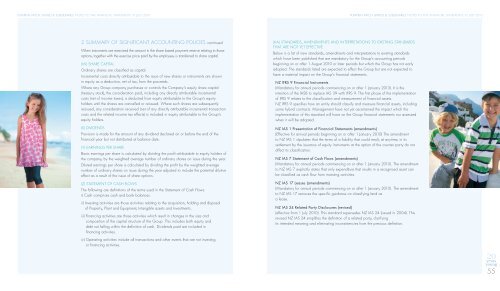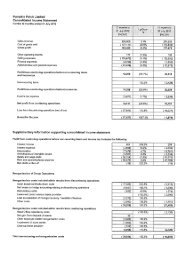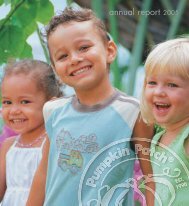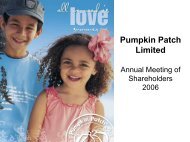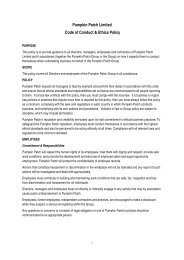Group Financial Statements/Auditors' Report - Pumpkin Patch ...
Group Financial Statements/Auditors' Report - Pumpkin Patch ...
Group Financial Statements/Auditors' Report - Pumpkin Patch ...
Create successful ePaper yourself
Turn your PDF publications into a flip-book with our unique Google optimized e-Paper software.
PUMPKIN PATCH LIMITED & SUBSIDIARIES NOTES TO THE FINANCIAL STATEMENTS 31 JULY 2010<br />
PUMPKIN PATCH LIMITED & SUBSIDIARIES NOTES TO THE FINANCIAL STATEMENTS 31 JULY 2010<br />
2 SUMMARY OF SIGNIFICANT ACCOUNTING POLICIES continued<br />
When instruments are exercised the amount in the share based payment reserve relating to those<br />
options, together with the exercise price paid by the employee, is transferred to share capital.<br />
(W) SHARE CAPITAL<br />
Ordinary shares are classified as capital.<br />
Incremental costs directly attributable to the issue of new shares or instruments are shown<br />
in equity as a deduction, net of tax, from the proceeds.<br />
Where any <strong>Group</strong> company purchases or controls the Company’s equity share capital<br />
(treasury stock), the consideration paid, including any directly attributable incremental<br />
costs (net of income taxes), is deducted from equity attributable to the <strong>Group</strong>’s equity<br />
holders until the shares are cancelled or reissued. Where such shares are subsequently<br />
reissued, any consideration received (net of any directly attributable incremental transaction<br />
costs and the related income tax effects) is included in equity attributable to the <strong>Group</strong>’s<br />
equity holders.<br />
(X) DIVIDENDS<br />
Provision is made for the amount of any dividend declared on or before the end of the<br />
financial year but not distributed at balance date.<br />
(Y) EARNINGS PER SHARE<br />
Basic earnings per share is calculated by dividing the profit attributable to equity holders of<br />
the company, by the weighted average number of ordinary shares on issue during the year.<br />
Diluted earnings per share is calculated by dividing the profit by the weighted average<br />
number of ordinary shares on issue during the year adjusted to include the potential dilutive<br />
effect as a result of the issue of share options.<br />
(Z) STATEMENT OF CASH FLOWS<br />
The following are definitions of the terms used in the Statement of Cash Flows:<br />
i) Cash comprises cash and bank balances.<br />
ii) Investing activities are those activities relating to the acquisition, holding and disposal<br />
of Property, Plant and Equipment, Intangible assets and Investments.<br />
iii) Financing activities are those activities which result in changes in the size and<br />
composition of the capital structure of the <strong>Group</strong>. This includes both equity and<br />
debt not falling within the definition of cash. Dividends paid are included in<br />
financing activities.<br />
(AA) STANDARDS, AMENDMENTS AND INTERPRETATIONS TO EXISTING STANDARDS<br />
THAT ARE NOT YET EFFECTIVE<br />
Below is a list of new standards, amendments and interpretations to existing standards<br />
which have been published that are mandatory for the <strong>Group</strong>’s accounting periods<br />
beginning on or after 1 August 2010 or later periods but which the <strong>Group</strong> has not early<br />
adopted. The standards listed are expected to effect the <strong>Group</strong> but are not expected to<br />
have a material impact on the <strong>Group</strong>’s financial statements.<br />
NZ IFRS 9 <strong>Financial</strong> Instruments<br />
(Mandatory for annual periods commencing on or after 1 January 2013). It is the<br />
intention of the IASB to replace IAS 39 with IFRS 9. The first phase of the implementation<br />
of IFRS 9 relates to the classification and measurement of financial assets.<br />
NZ IFRS 9 specifies how an entity should classify and measure financial assets, including<br />
some hybrid contracts. Management have not yet ascertained the impact which the<br />
implementation of this standard will have on the <strong>Group</strong> financial statements nor assessed<br />
when it will be adopted.<br />
NZ IAS 1 Presentation of <strong>Financial</strong> <strong>Statements</strong> (amendments)<br />
(Effective for annual periods beginning on or after 1 January 2010) The amendment<br />
to NZ IAS 1 stipulates that the terms of a liability that could result, at anytime, in its<br />
settlement by the issuance of equity instruments at the option of the counter party do not<br />
affect its classification.<br />
NZ IAS 7 Statement of Cash Flows (amendments)<br />
(Mandatory for annual periods commencing on or after 1 January 2010). The amendment<br />
to NZ IAS 7 explicitly states that only expenditure that results in a recognised asset can<br />
be classified as cash flow from investing activities.<br />
NZ IAS 17 Leases (amendments)<br />
(Mandatory for annual periods commencing on or after 1 January 2010). The amendment<br />
to NZ IAS 17 removes the specific guidance on classifying land as<br />
a lease.<br />
NZ IAS 24 Related Party Disclosures (revised)<br />
(effective from 1 July 2010). This standard supersedes NZ IAS 24 (issued in 2004). This<br />
revised NZ IAS 24 simplifies the definition of a related party, clarifying<br />
its intended meaning and eliminating inconsistencies from the previous definition.<br />
iv) Operating activities include all transactions and other events that are not investing<br />
or financing activities.<br />
20<br />
years<br />
young<br />
55


